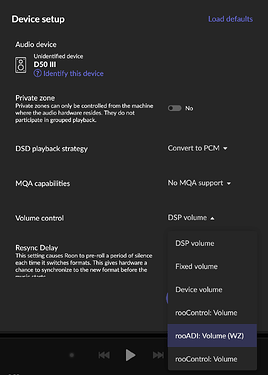So Jitter is practically impossible with USB. So from the theoretical point of view I would prefer USB and the Roon Streamer within rooExtend. Also one device less saves energy and rescued the planet 
Based on your explanation, I am convinced that it would be in my best interest to stream through RME+USB+RooExtend. I longer have FOMO for not using NODE, this makes it easier for me as well!
Next follow my recommendations regarding reference level in the ADI-2 and then see how much additional attenuation you need. The ADI-2 performs best running at its highest output voltage (6.9V).
I followed your recommendation based on your video about setting Auto Reference Level on RME. After which, my regaler listening volume would be between -55dB to -25dB on RME (my outlier listing window would add an additional -/+5dB [i.e. -60dB to -20dB])
You noted that
“ADI-2 performs best running at its highest output voltage (6.9V)”
I am not sure what dB would that be equal too. But my assumption is that it’s ideal that my listening window on RME would be between -25dB to 5dB or -30dB to 0dB? Which is that the best window? If so I need around -30dB attenuation.
I searched RME Forum and I come across attenuator recommendation list, from which the most accessible for me is HOSA - ATT 448 which provides “Selectable -20 dB, -30 dB, or -40 dB attenuation”. There is also Shure A15AS 15-25 dB Attenuator
I am wondering if there is any issue with using “selectable” attenuator? For example do you think that the selector circuit (or connection) inside the attenuator create extra level of noise or anything like that? and If you think it’s better to get a non-selectable attenuator? Also, do you think that the make or brand is important? Or HOSA - ATT 448 is good for my purpose?
Alternatively, my amp NAD C298 has variable gain (I can go down by -20dB) but when I read this [NAD C298 Stereo Amplifier Review | Audio Science Review (ASR) Forum] it made me think using variable gain on my amp might not be a good idea. As per Amir:
“…I started measuring with fixed gain and was pleased to see the gain close to our nominal 29 dB…Distortion is vanishingly low at -120 dB and it is noise that brings it down to a very respectable 100 dB SINAD:…I was hoping to get even better performance by lowering the gain to 15 dB. That did not happen: We actually have more distortion and some mains noise as well!”
Please let me know if you agree that using selectable attenuator is better than using my amp variable gain?
AND regarding RooMax. I am contemplating whether I should buy the full licence, and I have a few questions. How frequently do you charge your RooMax remote based on your daily average use? Do you have to turn on/off the device when it goes on standby mode or anytime that you turn the knob it will automatically activate and change the volume? I have seamless experience with Surface Dial and I don’t have to be worry about changing freqnelty and anytime I touch it it works perfectly. I am wondering if this is also true with RooMax?

